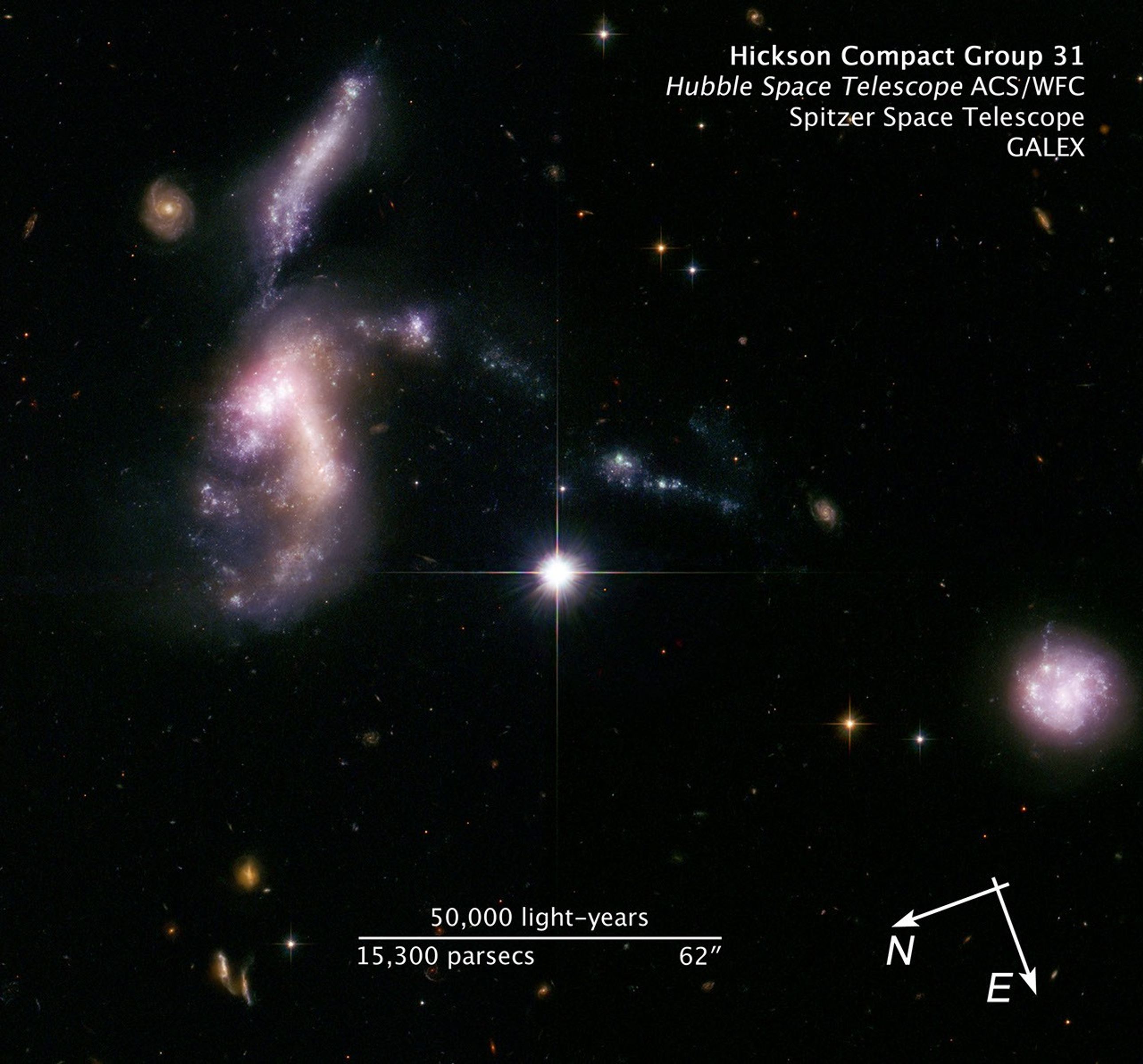1 min read
Hubble’s View of Hickson Compact Group 31

These four dwarf galaxies waited billions of years to come together, setting off a fireworks show as thousands of new star clusters come to life. The distorted galaxies are quickly producing massive, hot, young stars that are pumping out ultraviolet radiation, heating up surrounding gas clouds, and causing them to glow.
Such encounters between dwarf galaxies are normally seen billions of light-years away and therefore occurred billions of years ago. But these galaxies, members of Hickson Compact Group 31, are relatively nearby, only 166 million light-years away.
In this image, taken by NASA's Hubble Space Telescope, the bright, distorted object at middle, left, is actually two colliding dwarf galaxies. Myriad star clusters have formed in the streamers of debris pulled from the galaxies and at the site of their head-on collision. The cigar-shaped object above the galaxy duo is another member of the group. A bridge of star clusters connects the trio. A long rope of bright star clusters points to the fourth member of the group, at lower right. The bright object in the center is a foreground star.
Astronomers used Hubble's Advanced Camera for Surveys to resolve the youngest and brightest of star clusters, which allowed them to calculate the clusters' ages, map the star-formation history, and determine that the galaxies are starting the final stages of galaxy assembly. Hubble reveals that the brightest clusters, hefty groups each holding at least 100,000 stars, are less than 10 million years old.
Astronomers say the interacting galaxies will form a large elliptical galaxy in another billion years.
The Advanced Camera for Surveys data were taken on Aug. 8, 2006. The principal investigator was Jane Charlton of Pennsylvania State University, University Park.
About the Object
- R.A. PositionR.A. PositionRight ascension – analogous to longitude – is one component of an object's position.05h 1m 38.74s
- Dec. PositionDec. PositionDeclination – analogous to latitude – is one component of an object's position.-4° 15' 34.1"
- ConstellationConstellationOne of 88 recognized regions of the celestial sphere in which the object appears.Eridanus
- DistanceDistanceThe physical distance from Earth to the astronomical object. Distances within our solar system are usually measured in Astronomical Units (AU). Distances between stars are usually measured in light-years. Interstellar distances can also be measured in parsecs.166 million light-years (51 million parsecs)
- DimensionsDimensionsThe physical size of the object or the apparent angle it subtends on the sky.This image is 3.2 arcminutes (156,000 light-years or 48,000 parsecs) wide.
About the Data
- Data DescriptionData DescriptionProposal: A description of the observations, their scientific justification, and the links to the data available in the science archive.
Science Team: The astronomers who planned the observations and analyzed the data. "PI" refers to the Principal Investigator.This image was created from HST data from proposal 10787: J. Charlton (Pennsylvania State University), A. Zabludoff (University of Arizona), M. de Oliveira (University of São Paulo, Brazil), J. Hibbard (AURA/NRAO), S. Zonak (University of Maryland), A. Hornschemeier (NASA/GSFC), P. Hickson (University of British Columbia), J. Mulchaey (Carnegie Institution of Washington), K. Johnson (University of Virginia), A. Maybhate (STScI), R. Chandar (University of Toledo), S. Gallagher (The University of Western Ontario), C. Palma, S. Hunsberger, N. Brandt, and M. Eracleous (Pennsylvania State University), P. Durrell (Youngstown State University), J. English (University of Manitoba), B. Whitmore (STScI), D. Elmegreen (Vassar College), and K. Knierman (Arizona State University). The science team comprises: S. Gallagher (The University of Western Ontario), P. Durrell (Youngstown State University), D. Elmegreen (Vassar College), R. Chandar (University of Toledo), J. English (University of Manitoba), J. Charlton, C. Gronwall, and J. Young (Pennsylvania State University), P. Tzanavaris (NASA/GSFC), K. Johnson (University of Virginia/NRAO), M. de Oliveira (University of São Paulo, Brazil), B. Whitmore (STScI), A. Hornschemeier (NASA/GSFC), et al. - InstrumentInstrumentThe science instrument used to produce the data.HST>ACS/WFC
- Exposure DatesExposure DatesThe date(s) that the telescope made its observations and the total exposure time.August 8, 2006, Exposure Time: 1.1 hours
- FiltersFiltersThe camera filters that were used in the science observations.F435W (B), F606W (V), and F814W (I)
- Object NameObject NameA name or catalog number that astronomers use to identify an astronomical object.Hickson Compact Group 31, HCG 31
- Object DescriptionObject DescriptionThe type of astronomical object.Galaxy Group
- Release DateFebruary 18, 2010
- Science ReleaseJurassic Space: Ancient Galaxies Come Together After Billions of Years
- CreditNASA, ESA, J. English (University of Manitoba), and the Hubble Heritage Team (STScI/AURA); Acknowledgment: S. Gallagher (The University of Western Ontario)
Related Images & Videos

Hickson Compact Group 31: Interacting Galaxies Aglow with Millions of Young Stars
These four dwarf galaxies waited billions of years to come together, setting off a fireworks show as thousands of new star clusters come to life. The distorted galaxies are quickly producing massive, hot, young stars that are pumping out ultraviolet radiation, heating up...
Share
Details
Claire Andreoli
NASA’s Goddard Space Flight Center
Greenbelt, Maryland
claire.andreoli@nasa.gov































